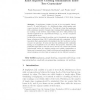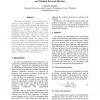431 search results - page 3 / 87 » Drawing Phylogenetic Trees |
WEA
2010
Springer
14 years 29 days ago
2010
Springer
A tanglegram consists of a pair of (not necessarily binary) trees T1, T2 with leaf sets L1, L2. Additional edges, called tangles, may connect nodes in L1 with those in L2. The task...
BMCBI
2010
13 years 6 months ago
2010
Background: Many bioinformatics analyses, ranging from gene clustering to phylogenetics, produce hierarchical trees as their main result. These are used to represent the relations...
BIOINFORMATICS
2010
13 years 6 months ago
2010
Phylogenetic trees are widely used to display estimates of how groups of species evolved. Each phylogenetic tree can be seen as a collection of clusters, subgroups of the species ...
CSB
2005
IEEE
13 years 11 months ago
2005
IEEE
Traditional phylogenetic tree reconstruction is based on point mutations of a single gene. This approach is hardly suitable for genomes whose genes are almost identical and hardly...
ALMOB
2007
13 years 6 months ago
2007
Background: Neighbor-Net is a novel method for phylogenetic analysis that is currently being widely used in areas such as virology, bacteriology, and plant evolution. Given an inp...


